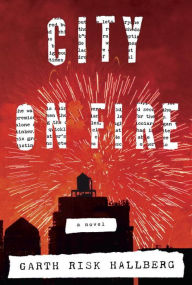Critics have been comparing Garth Risk Hallberg’s first novel, City on Fire, and its representation of late-1970s New York City to Charles Dickens’ A Tale of Two Cities and its London in upheaval.
In true Dickensian form, Hallberg’s 900-page novel dives into late-1970s New York City: corrupt millionaires, punk rockers, graffiti artists and drugs. As with most other behemoth novels, Hallberg creates almost a dozen characters and then intricately winds each of their stories together with one fatal scene: a young girl found shot dead in the snow on New Year’s Eve.
Most of the main characters in the novel are running from the suffocating presence of their parents and into the chaos of the city. William Hamilton-Sweeny was the lead singer of punk band Ex Post Facto before he was pushed aside by Nicky Chaos, another member of the band.
William is the only son of the Hamilton-Sweeneys, a family that uses its massive wealth to manipulate the entire city and the people within it. He abandoned his family years ago to pursue his passion for art, music and drugs, but now finds himself being drawn inextricably back in.
Samantha is a young girl from Long Island who, in her attempts to get away from her churlish father, discovers punk rock, specifically the music of Ex Post Facto, and is drawn into the city to experience more of this scene. She falls in love with Nicky Chaos and his friends, who form the Post-Humanist Phalanx, an anarchist terrorist cell intent on reinvigorating the city.
Mercer is a gay, black man trying to shed his Southern roots and the judgment of his parents. He moves to New York from Georgia to become an English teacher, and quickly falls in love with William.
The characters are believable, though awfully predictable.The most sluggish parts of the book are when Hallberg dedicates pages upon pages to characters’ backstories that the reader could have intuited for herself.
The most compelling character, though, is the city itself. It is cold and unyielding, but each person is helplessly drawn to it. Even as the city breaks them and changes them, they keep coming back, surging forward into the dark of the unknown.
This metaphorical dark crashes with the literal when the Great New York Blackout of July 1977 hits the city. Up until this point, time has surged back and forth through the months that preceded and followed the night of Samantha’s murder.
In the blackout, though, time shudders to a halt. The reader knows that the blackout is going to be the climax of the story. Everything will be made clear in the dark, a nice little irony that Hallberg plays with. Everything is racing towards this point, but it takes Hallberg almost 150 pages to get there. No author can maintain a sense of suspense for that long.
That is Hallberg’s downfall. It isn’t that his story is uninteresting; it’s that he takes too long to tell it.
He bogs himself down in detailed backstories and characters that hardly deserve the thousands of words that he dedicates to them. He stalls whole paragraphs with flowery writing that shows off his skill as a writer but hugely distracts the reader from what’s actually going on.
Ultimately, Hallberg tries to fit the whole of New York City in a novel, and that’s just not possible.







